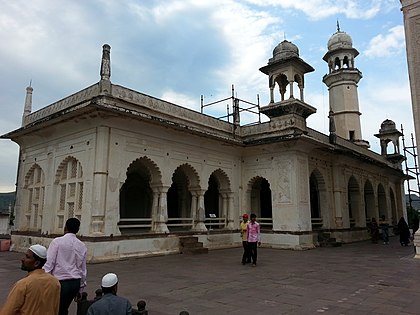
Mirza Abu'l Fayaz Qutb-ud-Din Mohammad Azam, commonly known as Azam Shah, was briefly the seventh Mughal emperor from 14 March to 20 June 1707. He was the third son of the sixth Mughal emperor Aurangzeb and his chief consort Dilras Banu Begum.

Mughal architecture is the type of Indo-Islamic architecture developed by the Mughals in the 16th, 17th and 18th centuries throughout the ever-changing extent of their empire in the Indian subcontinent. It developed from the architectural styles of earlier Muslim dynasties in India and from Iranian and Central Asian architectural traditions, particularly Timurid architecture. It also further incorporated and syncretized influences from wider Indian architecture, especially during the reign of Akbar. Mughal buildings have a uniform pattern of structure and character, including large bulbous domes, slender minarets at the corners, massive halls, large vaulted gateways, and delicate ornamentation; examples of the style can be found in modern-day Afghanistan, Bangladesh, India and Pakistan.

Tomb of I'timād-ud-Daulah is a Mughal mausoleum in the city of Agra in the Indian state of Uttar Pradesh. Often described as a "jewel box", sometimes called the "Bachcha Taj" or the "Baby Taj", the tomb of I'timād-ud-Daulah is often regarded as a draft of the Taj Mahal.
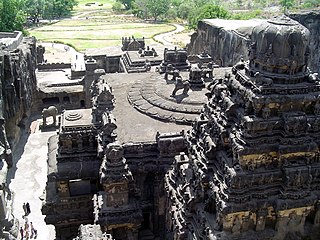
Aurangabad district, officially known as Chhatrapati Sambhaji Nagar district, is one of the 36 districts of the state of Maharashtra in western India. It borders the districts of Nashik to the west, Jalgaon to the north, Jalna to the east, and Ahmednagar to the south. The city of Aurangabad houses the district's administrative headquarters. The district has an area of 10,100 km2, of which 37.55% is urban and the rest is rural. Aurangabad District is a major tourism region in Marathwada.

Indo-Islamic architecture is the architecture of the Indian subcontinent produced by and for Islamic patrons and purposes. Despite an initial Arab presence in Sindh, the development of Indo-Islamic architecture began in earnest with the establishment of Delhi as the capital of the Ghurid dynasty in 1193. Succeeding the Ghurids was the Delhi Sultanate, a series of Central Asian dynasties that consolidated much of North, East, and Central India, and later by the Mughal Empire during the early 16th century. Both of these dynasties introduced Islamic architecture and art styles from West Asia into the Indian subcontinent.

Zeb-un-Nissa was a Mughal princess and the eldest child of Emperor Aurangzeb and his chief consort, Dilras Banu Begum. She was also a poet, who wrote under the pseudonym of "Makhfi".

Khuldabad is a city and a Taluka of Aurangabad district in the Indian state of Maharashtra. It is known as the Valley of Saints, or the Abode of Eternity, because in the 14th century, several Sufi saints chose to reside here. The Bhadra Maruti Temple and Dargah of Zar Zari Zar Baksh, Shaikh Burhan ud-din Gharib Chisti and Shaikh Zain-ud-din Shirazi, along with the tomb of the Mughal emperor Aurangzeb and his trusted General Asif Jah I, the first Nizam of Hyderabad, are located in this town. It is a holy and spiritual city of Islamic saints.

Mirza Muhammad Akbar was a Mughal prince and the fourth son of Emperor Aurangzeb and his chief consort Dilras Banu Begum. He went into exile in Safavid Persia after a failed rebellion against his father in the Deccan.
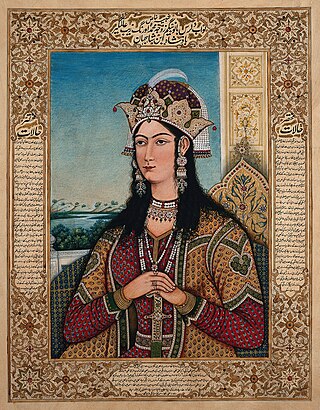
Dilras Banu Begum was the first wife and chief consort of Emperor Aurangzeb, the sixth Mughal emperor. She is also known by her posthumous title, Rabia-ud-Durrani. The Bibi Ka Maqbara in Aurangabad, which bears a striking resemblance to the Taj Mahal, was commissioned by her husband to act as her final resting place.

Maharashtra state in India is known for its Famous caves and cliffs. It is said that the varieties found in Maharashtra are wider than the caves and rock-cut architecture found in the rock cut areas of Egypt, Assyria, Persia and Greece. The Buddhist monks first started these caves in the 2nd century BC, in search of serene and peaceful environment for meditation, and they found these caves on the hillsides.
Zinat-un-Nissa Begum was a Mughal princess and the second daughter of Emperor Aurangzeb and his chief consort, Dilras Banu Begum. Her father had conferred upon her the honorable title of Padshah Begum.
Aurangabadi Mahal was a consort (concubine) of the Mughal emperor Aurangzeb.
Shahar Banu Begum was Empress consort of the Mughal Empire from 14 March 1707 to 8 June 1707 as the third wife of Emperor Muhammad Azam Shah. She is popularly known by the titles Padishah Bibi and Padshah Begum.
Events in the year 1707 in India.
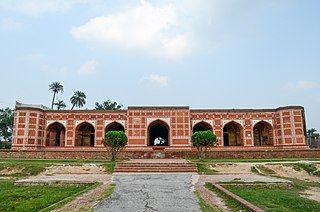
The Tomb of Nur Jahan is a 17th-century mausoleum in Lahore, Pakistan, that was built for the Mughal empress Nur Jahan. The tomb's marble was plundered during the Sikh era in 18th century for use at the Golden Temple in Amritsar. The red sandstone mausoleum, along with the nearby tomb of Jahangir, tomb of Asif Khan, and Akbari Sarai, forms part of an ensemble of Mughal monuments in Lahore's Shahdara Bagh.

Persian Inscriptions on Indian Monuments is a book written in Persian by Dr Ali Asghar Hekmat E Shirazi and published in 1956 and 1958 and 2013. New edition contains the Persian texts of more than 200 epigraphical inscriptions found on historical monuments in India, many of which are currently listed as national heritage sites or registered as UNESCO world heritage, published in Persian; an English edition is also being printed.

The Tomb of Aurangzeb is located in Khuldabad, Aurangabad district, Maharashtra, India. In notable contrast to other Mughal tombs, which are large monuments of Mughal architecture, including the Taj Mahal, at his own direction Aurangzeb is buried in an unmarked grave at the complex of the dargah or shrine of Sheikh Zainuddin.
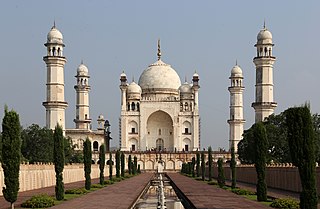
'Ataullah Rushdi bin Ahmad Ma'mar was a 17th-century architect and a mathematics writer from the Mughal Empire of present-day India. He designed the Bibi Ka Maqbara at Aurangabad and some buildings at Shahjahanabad. As a mathematics writer, he translated the Arabic-language Khulasat al-Hisab and the Sanskrit-language Bijaganita into Persian.









